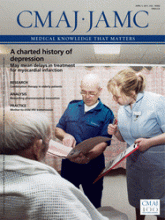Canadian palliative care programs are generally created with the needs of mainstream society in mind. Though these systems attempt to accommodate everyone, the unique challenges of serving marginalized populations make this difficult. And there is perhaps no population more challenging to assist in dying than the homeless.
Yet this population needs support more than most others, says Wendy Muckle, executive director of Ottawa Inner City Health, a program in Ottawa, Ontario, that aims to help homeless people receive the same quality of health care as other Canadians.
“With the homeless, I would argue that their need and right to have support through the end of life is even greater than the mainstream populations because of the suffering they have already experienced in their lives and the fact that their housing status would imply that they have poorer capacity to cope then others,” Muckle writes in an email.
“However, to take the values of palliative care and apply them to the homeless is problematic as sometimes the values are not the same or the interpretation of the values is pretty different. The challenge to health providers is to suspend judgement and truly accept the right of the homeless patient to define the end of life experience from their own values and perspective.”
Since most palliative care services are offered in hospitals, homeless people are unlikely to use them. The homeless often fear they will be treated poorly by hospital staff and judged harshly by other patients, says Paddy Bowen, executive director of St. Felix Centre, a community centre that offers a range of social services, including care for the homeless, in Toronto, Ontario.
“Homeless people are generally allergic to the health care system,” says Bowen. “They don’t trust authority of any kind.”
Most health care providers are ill-equipped to care for homeless people anyway, notes Bowen. The extent of their training might be a two-week workshop on working with the marginalized, she says, which does not provide them with the practical experience they need. Palliative care program directors who genuinely want to help homeless people during their final days would be wise to partner with homeless shelters, suggests Bowen.

A doctor examines a man at a homeless shelter in Venice Beach, California as part of a program designed to provide free medical care to people in shelters.
Image courtesy of Reuters/Lucy Nicholson
“You need caregivers who are not easily offended and not judgemental. They need to have strong stomachs for dirt of all kinds,” she says. “The idea of expecting mainstream medicine to develop expertise around serving the homeless is a bit naive.”
The best means of providing palliative care to the homeless, according to people who work in this area, is to bring the services to the place they feel most comfortable: homeless shelters. CMA President Dr. Jeffrey Turnbull, who cofounded the Ottawa Inner City Health Project and is still its medical director, is a proponent of this idea and helped to establish a palliative hospice in an Ottawa homeless shelter.
According to Turnbull, homeless people have lived outside the mainstream health system their entire lives and to make them live their last days in that system would only add to their suffering.
“Our hospice is right in the shelter. That’s their home,” says Turnbull. “Most people want to die at home. Why would they think any differently? They want to be among their friends.”
An analysis of 28 terminally ill people who died at the hospice found that providing palliative care in a shelter can not only be effective, but can also save money (Palliat Med 2006;20:81-6). The patients stayed in care an average of 120 days, at a projected savings of $1.39 million compared to similar stays in mainstream care locations.
“The homeless terminally ill have a heavy burden of disease including physical illness, psychiatric conditions and addictions,” the report states. “Shelter-based palliative care can provide effective end-of-life care to terminally ill homeless individuals at potentially substantial cost savings.”
The lead author of that report was Dr. Tiina Podymow, an assistant professor of nephrology at the McGill University Health Centre in Montréal, Quebec. The homeless people who accessed the in-shelter hospice were incredibly grateful to have a bed and people to care for them in an environment where they felt comfortable, says Podymow.
“They have a lot of addictions and many are chronic smokers, so hospitals are not the best place for them to die in character,” says Podymow. “They can’t do things that were part of their lives.”
Of course, no matter the location, providing palliative care to the homeless is fraught with challenges. Many homeless people are addicted to alcohol and drugs, and administering pain-relief medication to an addict requires striking a balance between providing comfort and abetting addiction. Mental illness is also common in homeless populations, which makes communication about their care difficult. Add in such illnesses as liver disease and HIV/AIDS, and the process only becomes more complicated.
“You have to treat every patient as a unique case,” says Turnbull. “These people have such complex problems.”
Editor’s note: Eleventh of a series on end-of-life care
Part I: Preparing for the inevitable
(www.cmaj.ca/cgi/doi/10.1503/cmaj.109-3704)
Part II: Advance directives: obstacles in preparing for the worst
(www.cmaj.ca/cgi/doi/10.1503/cmaj.109-3743)
Part III: End-of-life planning framework calls for fewer checklists, more conversation (www.cmaj.ca/cgi/doi/10.1503/cmaj.109-3746)
Part IV: Tools help patients tackle tough choices for end-of-life care
(www.cmaj.ca/cgi/doi/10.1503/cmaj.109-3750)
Part V: National home care standards urged
(www.cmaj.ca/cgi/doi/10.1503/cmaj.109-3731)
Part VI: Access to palliative care varies widely across Canada
(www.cmaj.ca/cgi/doi/10.1503/cmaj.109-3763)
Part VII: Framework urges physicians to proceed with caution on palliative sedation (www.cmaj.ca/cgi/doi/10.1503/cmaj.109-3766)
Part VIII: Pocket-sized help for people with dementia
(www.cmaj.ca/cgi/doi/10.1503/cmaj.109-3705)
Part IX: Grief therapy for those left behind
(www.cmaj.ca/cgi/doi/10.1503/cmaj.109-3793)
Part X: Providing hospice in the womb











